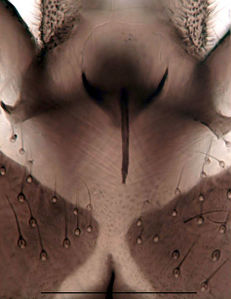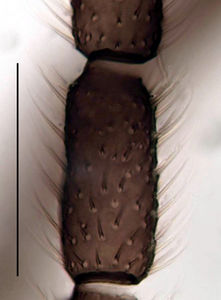Difference between revisions of "Leptospina truncata"
Kai Heller (Talk | contribs) |
Kai Heller (Talk | contribs) |
||
| Line 71: | Line 71: | ||
|7= File:Leptosciarella truncata Gonostylus dorsal KH5927.jpg|8= '''Figure 4.''' ''Leptospina truncata'' male, gonostylus (dorsal view), scale 0.1 mm | |7= File:Leptosciarella truncata Gonostylus dorsal KH5927.jpg|8= '''Figure 4.''' ''Leptospina truncata'' male, gonostylus (dorsal view), scale 0.1 mm | ||
|9= File:Leptosciarella truncata Tegmen KH5927.jpg|10= '''Figure 5.''' ''Leptospina truncata'' male, aedeagal complex, scale 0.1 mm | |9= File:Leptosciarella truncata Tegmen KH5927.jpg|10= '''Figure 5.''' ''Leptospina truncata'' male, aedeagal complex, scale 0.1 mm | ||
| − | |11= File:Leptosciarella truncata Antenna KH5940.jpg|12= '''Figure 6.''' ''Leptospina truncata'' male, 4<sup>th</sup> | + | |11= File:Leptosciarella truncata Antenna KH5940.jpg|12= '''Figure 6.''' ''Leptospina truncata'' male, 4<sup>th</sup> antennal flagellar segment, scale 0.1 mm |
|13= File:Leptosciarella truncata Palpus KH5940.jpg|14= '''Figure 7.''' ''Leptospina truncata'' male, palpus, scale 0.1 mm | |13= File:Leptosciarella truncata Palpus KH5940.jpg|14= '''Figure 7.''' ''Leptospina truncata'' male, palpus, scale 0.1 mm | ||
|15= File:Leptosciarella truncata Wing KH5940.jpg|16= '''Figure 8.''' ''Leptospina truncata'' male, wing, scale 1 mm | |15= File:Leptosciarella truncata Wing KH5940.jpg|16= '''Figure 8.''' ''Leptospina truncata'' male, wing, scale 1 mm | ||
Latest revision as of 19:19, 1 January 2021
Ordo: Diptera
Familia: Sciaridae
Genus: Leptospina
Name
Leptospina truncata (Tuomikoski, 1960) – Wikispecies link – ZooBank link
- Trichosia (Leptosciarella) truncata Tuomikoski, 1960[1]: 27, fig. 5c
- Leptosciarella (Leptosciarella) truncata (Tuomikoski, 1960)[2]: 80-81, fig. 31
Type material
Lectotype: ♂, 02.08.1958, leg. Tuomikoski in MZH
Type locality
Norway, Finmark, Langfjordelva
Material studied
Norway: 1 ♂, Finmark, Varanger peninsula, Syltefordsfjell, SE Batsfjord, Jaschhof, 27.06.1992, PWMP 1784; 1 ♂, Vadsö, deciduous forest with birch, shrubs, exhaustor, Jaschhof, 10.07.1994, PWMP 1781; Russia: 7 ♂, Tuva, Ishti-Khem, Krivosheina, 28.06.1974, PWMP 1773/1776-1780/1783; 3 ♂, Jushnyi Yamal, Olschwang, 30.07.1981, PWMP 1774/1775/1782; Sweden: 3 ♂, Härjedalen, Nyvallen, Nyvallens fäbod: alpine birch and spruce wood, Malaise trap, Swedish Malaise Trap Project, 4.7.-04.08.2004, NHRS 1789/3412/3413; 6 ♂, Torne lappmark, Abisko, birch forest, northern slope, yellow pan trap, Tschirnhaus, 13.-17.07.1991, PWMP 1785-1790; 5 ♂, Nikkaluokta, young birch/willow forest along stream, Malaise trap, Jaschhof & Jaschhof, 14.7.-05.08.2005, PKHH 5927/5940, NHRS 1060/1064, ZSMC 2409; 1 ♂, Ångermanland, Skuleskogen National Park, Västernorrlans län, Langra: brook ravine in mixed forest, Malaise trap, Swedish Malaise Trap Project, 24.7.-12.09.2005, NHRS 3711.
Description (male)
Head. Eye bridge 3–4 rows of facets. LW-index of 4th antennal flagellar segment 2.1–2.3; neck 0.3–0.4 of segment width; Transition of basal part to neck pronounced. Colour of neck unicolour. Antennal hairs shorter than segment width; sparse; salient. Palps darkened; normal; palpomeres 3. First palpomere of normal shape; with 2–4 bristles; with only some sparse sensillae. Second palpomere shortly oval. Third palpomere as long as first segment. Thorax. Colour brown. Notum unicolorous. Thoracic setae weak; bright. Mesonotum with some weaker central bristles. Posterior pronotum setose. Postpronotal setae 1–3; fine. Laterotergite bare. Legs. Colour yellow, or yellow-brown. Hind coxae of same colour as femora. Hairs on fore coxae bright. Front tibia apically with a patch of setae. Front tibial organ dark. Front tibial organ not bordered. Tibial setae on hind legs normal, shorter than tibial width. Tibial spurs of equal length. Claws untoothed. Wings. Wings slightly darkened; of normal shape. Wing membrane without macrotrichia. Wing venation weak, with faint m-base. M-fork of normal shape. R1 inserting clearly before base of m-fork; posterior veins bare; bM bare; r-m bare, or with a few setae; bM:r-M 0.66–0.8; st-Cu:bM 0.45–0.65; r1:r 0.9–1.2; C:w 0.45–0.6. Halteres dark; of normal length. Abdomen. Abdominal setae weak; dorsally white; ventrally white. Hypopygium concolour with abdomen; 0.6–0.7 × longer than wide. Base of gonocoxites with normal, weak hairs; gonocoxites forming an inverse V; inner margin of gonocoxites normally U-shaped; inner part of hypopygium scarcely setose; elongated setae on valves of hypopygium absent. Gonostylus elongate; 2.25–2.5 × longer than wide; Inner margin concave; apex equally rounded, or bulbous. Apical tooth present; 1.8–2.2 × longer than broad; strong. Awl-like setae long; on inner side of gonostyles absent. Megasetae on inner part of gonostylus absent. Whiplash-hair absent. Tegmen 0.45–0.6 × longer than broad; equally rounded, or trapezoid; normal; Central process absent. Length of aedeagus/hypopygium 20–30 %; Aeadeagal apical structure present. Measurements. Body size 2.5–2.9 mm. Hind tibia 1–1.3 mm. Wing length 2.1–2.5 mm.
Diagnosis
Leptospina truncata is a small species, characterized by bright body hairs and lacking macrotrichia on the posterior wing veins. It is very similar to Leptospina nudinervis, which can be distinguished by the apically less bulbous gonostyli, the dark body hairs and the longer antennae. The apical bulge at the gonostyles is still more expressed in the closely related Leptospina nigrosetosa, which otherwise bares longer, stronger and dark body hairs.
DNA Barcoding
COI sequences are assigned to the following BINs:
- BOLD:ACS3492 (average distance 0.25%, max. 0.72%, n=8, K2P: 3.21%)
- BOLD:ADL4747 (n=1, K2P: 3.21%)
- BOLD:ACU7107 (average distance 1.2%, max. 1.8%, n=8, K2P: 4.31%)
Discussion
This species belongs to a group of mostly boreal species with reduced macrotrichia on the wings and a V-shaped bright structure at the base of the gonostyli, both typical characters for the genus Leptospina. Although the dorso-apical awl-like setae are not as robust as in typical Leptospina like Leptospina dentata, this species is now placed in Leptospina and not in Trichosiopsis any more, which is also supported by genetic evidence.
Le. truncata is constituted by three different genetic variants with K2P distance of more than 3% each. Specimens of the most widespread BIN BOLD:ACS3492 agree best with the original description and are therefore regarded as Le. truncata truncata, whereas the two other BINs are treated as subspecies.
Etymology
lat. truncatus = truncated; making reference to the cut off apical part of the gonostylus.
Ecology
Leptospina truncata is a species of boreal forests.
Distribution
Finland[1], Norway[1][2], Russia[3][2], Sweden[4].
Subspecies list
Leptospina truncata excentrica - Leptospina truncata tertia - Leptospina truncata truncata
Images
|
References
- ↑ 1.0 1.1 1.2 Tuomikoski, R. 1960: Zur Kenntnis der Sciariden (Dipt.) Finnlands. Annales Zoologici Societatis Zoologicae Botanicae Fennicae “Vanamo”, 21, 1–164.
- ↑ 2.0 2.1 2.2 Mohrig, W.; Menzel, F. 1997: Revision der paläarktischen Arten von Trichosia Winnertz sensu Tuomikoski, 1960 (Diptera, Sciaridae). – Teil II. Gattungen Leptosciarella Tuomikoski, 1960 und Trichodapus gen. nov. Studia dipterologica, 4(1), 41–98.
- ↑ Mohrig, W.; Krivosheina, N.; Mamaev, B. 1985: Beiträge zur Kenntnis der Trauermücken (Diptera, Sciaridae) der Sowjetunion. Teil VII: Neue Arten aus dem Amur-Gebiet. Zoologische Jahrbücher, Abteilung für Systematik, Ökologie und Geographie der Tiere, 112(2), 249–260.
- ↑ Heller, K.; Vilkamaa, P.; Hippa, H. 2009: An annotated check list of Swedish black fungus gnats (Diptera, Sciaridae). Sahlbergia, 15(1), 23-51.







